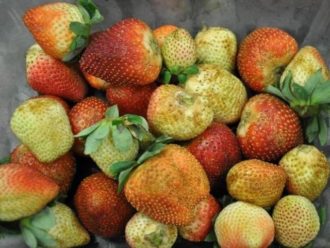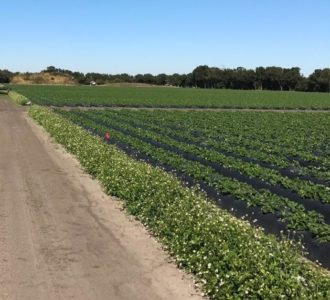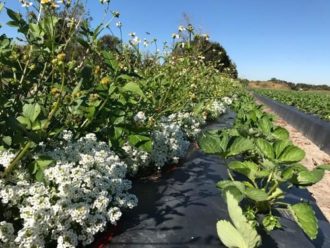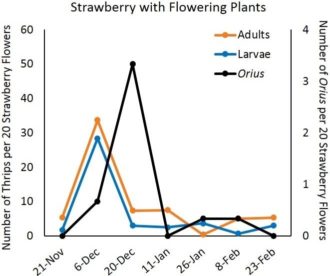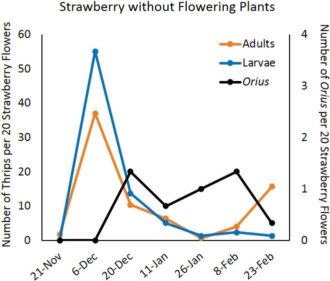WIMAUMA, Florida -- Over the last few years, Florida strawberry growers have been faced with declining market prices, increased global competition, and suspected and documented cases of insecticide resistance. In addition, growing concerns for overall environmental health have increased as we see trends of habitat loss and declining biodiversity, specifically of natural enemies and pollinators.
Flower thrips are a major pest of strawberry and can damage flowers and fruit. Minute pirate bugs are effective thrips predators and may benefit from adding floral resources in agricultural settings. Researchers at the University of Florida are investigating the use of wildflower plantings along strawberry field edges as one potential method to conserve natural enemies and pollinators while still meeting grower needs. The working hypothesis is that these flowering plants serve as a source of beneficial insects that will move into adjacent strawberries to provide pest control services and greater levels of pollination than in strawberries without flowering plants.
Major goals of the project are:
- To evaluate if adding non-crop resources to field edges can reduce flower thrips numbers to economically acceptable populations
- To increase abundance and diversity of natural enemies (conservation biological control) and pollinators
- And to reduce pest damage to strawberry crops and increase yield resulting from increased pest management, pollination, and other ecosystem services provided from additional floral resources
Priority was placed on obtaining and using new knowledge of relationships between flowering plants and natural enemies and pollinators in a subtropical farming zone.
Two native flowering plants, sweet alyssum (Lobularia maritima) (compact plants, many small white flowers) and Spanish needles (Bidens alba) (larger plants, white flowers) were planted on the edge of strawberry fields in an organic strawberry field in Hillsborough County, FL (Figs. 2 and 3). Throughout the season, thrips and minute pirate bugs populations were monitored in the strawberry flowers in the row immediately next to and 6 rows from the flowering plants. Predators, parasitoid wasps, and pollinators were observed in the same rows. Strawberry yield and quality was also assessed, specifically for berries damaged by thrips and those that are poorly pollinated (deformed or misshapen).
Thrips were reduced and minute pirate bugs were increased in the strawberry in the row next to the flowering plants compared to the plots without flowering plants (Figs. 4a and 4b). Overall abundance and diversity of natural enemies and pollinators were also increased with the addition of the flowering plants and mainly included hover flies, lacewings, spiders and several wasps.
Although adding flowering plants increased the recruitment of minute pirate bugs following peaks of flower thrips populations, this was only observed in the row closest to the flowering plants. Additional thrips injury and yield data are required to determine effects on strawberry yield and quality, and future experiments will be conducted to increase dispersal of natural enemies, especially minute pirate bugs, further into the field. These results, however, highlight the potential of flowering plants to serve as a resource for conserving natural enemies and other beneficial insects while reducing pest populations as an alternative method for pest management.
Published by the University of Florida and reprinted by Southern SARE under the permission of University of Florida. Written by Joe Funderburk. Funded by the USDA National Institute of Food and Agriculture (NIFA), Southern SARE operates under cooperative agreements with the University of Georgia, Fort Valley State University, and the Kerr Center for Sustainable Agriculture to offer competitive grants to advance sustainable agriculture in America's Southern region. This material is based upon work that is supported by the National Institute of Food and Agriculture, U.S. Department of Agriculture, through Southern Sustainable Agriculture Research and Education, under sub-award number: OS16-098 . USDA is an equal opportunity employer and service provider. Any opinions, findings, conclusions, or recommendations expressed in this publication are those of the author(s) and do not necessarily reflect the view of the U.S. Department of Agriculture.
